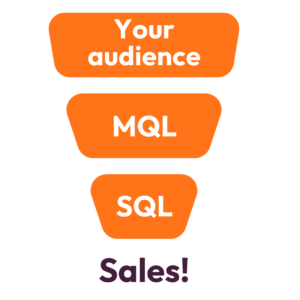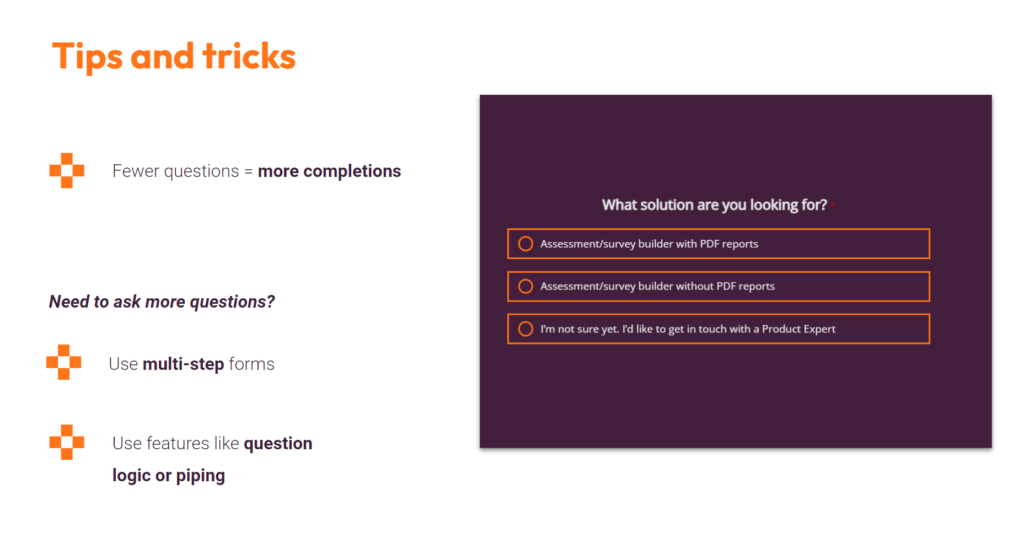If you’ve found your way to this article, chances are you’re in charge of the daunting task of finding more customers for your business. Finding and attracting new leads is easier said than done. Tell me about it. One thing I’ve learned as a performance marketer at Pointerpro over the years is this: It never hurts to revisit the basics of lead generation. In fact, it helps to see things more clearly again.
And that’s what I hope to do with this article for you:
- How to define leads correctly: MQL vs SQL
- What is lead generation?
- Lead magnets
- Lead capture
- Lead magnet and lead capture in one solution: Pointerpro
* Don’t feel like reading right now? Check out my webinar on this very topic.
How to define leads correctly: MQL vs SQL
Before I delve further into lead generation, I’d like to raise awareness about one important distinction: MQL vs SQL.
A person who engages with your company and is deemed likely to become a customer down the road could be labeled “MQL” or “Marketing Qualified Lead. What is the crucial difference between an MQL and an SQL, or “Sales Qualified Lead”?
An SQL has shown real purchase intent, and an MQL has merely shown curiosity about your service, product – or even just your brand and the things you talk about (it’s up to you to define what indicates likeness to become a customer in the future).
Ultimately, you want to get SQLs, of course. Because you want to sell. But the reality is that most customers were MQLs before they became SQLs. If you only focus your attention on people who already have purchase intent (SQLs), you risk missing out on many potential sales.

Therefore, your first objective when you’re looking to sell more is this: Generate Marketing Qualified Leads. That’s the focus of this article.
What is lead generation?
So now that we’ve clarified the angle from which you’re shooting at whatever target you have in front of you, let’s define lead generation. But let’s do so in a way that spells out the fundamental actions of lead generation.
The dictionary definition of lead gen vs my definition of lead gen:
The Oxford definition mentions identifying and cultivating potential customers.

That first distinction between “identification” and “cultivation” is already useful. Indeed, they both go hand in hand. In fact, they go both ways. If people don’t identify themselves, you won’t be able to interact effectively with them and cultivate them into (potential) customers. On the other hand, some of that “cultivation” is necessary to make people want to identify themselves in the first place.
I call that preliminary cultivation “generation of interest.”
The interest comes from people’s awareness of their own or business’ pain points, or just from questions that they grapple with.
If you want to generate leads, you need to spark that interest. You need to press those pain points and answer those questions.
Why? Because if you don’t, you’ll only seize the low-hanging fruit. Out of 100 potential customers, only 5 of them book a demo, schedule a sales call, or start a free trial – if you’re lucky.
So, if I had to come up with a definition of lead generation, it would probably be something that sounded more like this:
“Lead generation is the process of generating interest in your product or service with the goal of eventually turning that interest into a sale.”
And, again, somewhere in the middle there, your lead will need to allow you to identify and contact them. Only then we can speak of lead capture. To pull the higher-hanging fruit over that threshold, you need a lead magnet.
What is a lead magnet?
Lead magnets are also often called “signup incentives,” or sometimes, more pejoratively, they’re referred to as “opt-in bribes.” No need to talk down on them like that, if you ask me.
A lead magnet is simply a (free) goodie offered to website visitors in exchange for their contact details. It’s simply something of value. It can be a discount code on the price of the product or service you’re offering, but it doesn’t have to be this direct.
More often than not, whether you sell a service or a product, your expertise is very valuable for potential customers too.
Therefore, powerful lead magnets are often a mini-guide, a specialized report on important matters for your potential customers, or even better, a personalized assessment of their situation (combined with a personalized PDF report).
Let’s make that more concrete with a few real-life examples.
Lead magnet examples
Ebooks or research reports
Pretty much the oldest lead magnet in the book, but still in the book for a reason: A classic ebook like this State of SEO 2024 report by Search Engine Journal®.

Leaders in their niche, like this company in the field of SEO marketing, need to keep their own expertise up to date by researching regularly anyway. So they might as well use their research to attract some new customers.
Adobe flips the concept around in a clever way. Instead of just offering results from their research, they offer their audience to take part in it by being surveyed. This is particularly interesting because the eventual ebook is in fact an aggregate report about all respondents. That means each respondent can sort of benchmark themselves against the entire group.

Guided selling reports
The last example shows why it’s interesting to involve your potential lead in the expertise you’re sharing. Depending on the type of business you’re running, you could even take it a step further. For precisely defined services or for actual products the following approach can be interesting:
Legion, a brand of fitness supplements, gives people the chance to find out “what type of supplements are right for them” by filling out a quiz. For many sporty people, this is actually really valuable information to have. Of course, the type of report that follows this quiz, contains actual product suggestions from Legion. In other words, the company not only captures lead data (= lead generation), it also starts to guide the website visitor down a path of potentially purchasing a product. At Pointerpro we refer to this type of quiz as a “guided selling assessment.”
I discuss it – followed by another example of a Pointerpro client, Boot Camp Digital’s maturity assessment – in this clip from my recent webinar.
Where should you promote your lead magnet?
So we’ve established that a lead magnet sparks the interest you want from potential.
Great. But you also need to ask yourself where you want people to find your lead magnet.” Here are a few examples for your inspiration:
On a website page
Consultant/coach Mark A Mears puts his free assessment front and center on his homepage. It’s hard to miss it.

Now, maybe this isn’t your style. Maybe you don’t feel like dedicating your entire website homepage to your lead magnet. In that case, you can build a dedicated landing page for it. You can lead people there via a button or via the navigation menu on your website.
Do you want to be even more subtle than that?
A third option is to promote your lead magnet via a call-to-action in your blog articles. Be sure to use articles that get sufficient traffic.
On social media
Social media may not sound like a revolutionary idea, but it has one major advantage: It’s a public channel on which you control your content.
Some pointers:
- Make sure your potential leads are using the social media channel. For B2B that often means Linkedin, rather than Instagram and Tiktok. Although things continually evolve.
- Company pages on social media are near-dead (if not dead entirely). Social media is all about thought leadership, so leverage your personal profile instead – or the profile of someone within your company that you want to establish as a thought leader
- Do more than just share your lead magnets. Engage with other profiles, and publish conversational posts yourself to simply establish your presence.
- Post consistently. You can’t do a monthly post and expect to see results.
If you follow these pointers, posting to promote a lead magnet every once in a while is bound to be successful.
On retargeting ads
This probably sounds familiar: You browse for a pair of shoes or maybe some financial consulting online, and next thing you know, these offerings appear everywhere you go online. Is it magic? Not really.
Basically, what the brand or company in question did was place a Facebook or LinkedIn (or Google) pixel in the code on their website. This created some sort of trace. Now someone comes in, reads a blog post, and checks out a few other pages. Tomorrow, when this same person procrastinates on social media, he or she sees a lead magnet from exactly the same brand or company show up.
This is called “retargeting.” It’s a great way for any business to stay top of mind and lure potential leads back.
But it’s not for free. I don’t necessarily recommend it as a beginner strategy.
On website pop-ups
This idea is contested by some marketers, but I personally don’t have an issue with pop-ups. You simply need to design the experience so that it doesn’t feel too intrusive.

Slide-in pop-ups that appear on the right or left side of the screen are perfect in my opinion.
Another smart pop-up approach: Exit intent pop-ups. These appear when someone moves his or her cursor out of the page. It’s a last-ditch effort to collect some information on the website visitor.
The latter is also a good spot to offer secondary lead magnets. For example, you may have used a landing page to promote your main lead magnet – say, an ebook.
As the visitor is about to leave the page without providing their contact information to download the ebook, you could use an exit intent pop-up and seduce them with something else – maybe a webinar you’re doing sometime soon around a similar topic your ebook talks about? After all, different people prefer different formats to learn.
What is lead capture?
If a lead magnet is what attracts potential customers or “leads,” then I’d define lead “capture” as, well… capturing the data that allow me to start interacting with these people.
Depending on the type of interactions you want to create from the get go, you may want to capture different data.
Obviously, the bare minimum would be contact data – a name and an email address – but depending on how you want to approach the lead in question, you may want to know more about him or her.
That brings me to some key tips I want to share – they concern both lead magnets and lead capture:
Lead magnet and lead capture tips
- Talk to potential customers in real life: This is becoming a bit of a lost art. If you’re in a service business, you generally do get this opportunity quite often. That means you’ll understand the pain points that exist and will be able to tie into them with relevant lead magnets.
- Go for scannable and/or personalized content: Don’t overestimate what a lead magnet should be. Leads will often prefer five short but highly relevant tips they never heard before over having to browse through 50 generic tips.
- Ask fewer questions to get more completions: When setting up a lead capture form, quiz, or assessment, you have to be critical of every question you ask. Ask yourself what you will do with the answer to each question. Do you really need the information right now?
The ideal lead capture form or quiz: Some key tips
Don’t get me wrong, more detailed questions in a lead capture form may allow you to personalize and improve further interactions. Some information can help you make future content you share more relevant.

If this is important in your specific case, I have three more tips for you:
- Use multi-step forms. In other words, don’t try to ask all your questions at once. It will overwhelm your respondent. Limit yourself to three form questions per screen/step, and it will become more digestible for your leads.
- I’d advise you to build your form with a tool that has features like question logic (also called branching). It will allow you to hide or skip certain questions, based on previous answers.
A highly simplified example: When you ask someone if they drive a car and the answer is no, you don’t want to follow up by asking what brand they drive. - Another key lead capture form feature to look for is “piping.” Thanks to this feature, you’re able to use answers from respondents on questions to feed your follow-up questions.
Another simple example:
- Initial question: What’s your favorite food?
- Selected answer options: “pizza”, “spaghetti,” and “lasagna.”
- Relevant follow-up question: “Why do you like Italian food so much?”

After lead capture comes lead nurture
So once the data are in, what’s next? It’s important to think ahead – from the very beginning – about how you want to interact with leads when you’ve finally retrieved the information you wanted from them.
The end of the lead generation process is only the start of the lead nurturing process.
Email nurturing
The reason why we all like email addresses so much, is simply because email is a straightforward way to nurture leads with relevant and personalized information. A lot depends on the data you’ve captured from your lead, of course.
In the example below, my first name and my company name (though capitalized incorrectly) are used in the subject line.

An important note: You might have noticed in the screenshot that I’ve been contacted several times in the same week. That’s a lot… I advise you to pace yourself and not email your lead every other day. Once a week is already a very nice rhythm – and only if you have relevant things to share.
Lead nurturing with follow-up lead magnets
In the email example above, you may also have noticed there are links to other lead magnets of the company in question, such as their “TCO calculator” (a cost-of-ownership calculator for their content management system). These items keep me – in this case, a lead for the company in question – aware of their offering.
You don’t necessarily even need to wait until you send your leads an email to warm them up for other goodies you have to offer. If your lead magnet is an ebook, for instance, nothing withholds you from using it to link to another ebook or a potentially relevant self-assessment you built.
Lead magnet and lead capture in one solution: Pointerpro
So to recapitulate: Here is the way most marketers define lead magnets and the way they define lead capture:
- “Lead magnets” are goodies that attract people. In the online world this is very often some type of valuable document like an ebook or a report.
- “Lead capture” is the act of retrieving the information you need from them (at the very least: contact information). In the online world this is usually through some sort of form.
Pointerpro clients basically build both in one solution. They use Pointerpro’s Questionnaire Builder and embed the resulting questionnaire on their website (or they link to it). Based on the different questions of their questionnaire, they use Pointerpro’s Report Builder to create a PDF report template.
The result? Whenever a respondent fills out a Pointerpro-built questionnaire, he or she receives a personalized feedback report in PDF format, based on the provided information or answers.
In other words, the resulting PDF report – promised ahead – is the lead magnet, and the questionnaire is the lead capture tool.
Want to find out more about this? Dive into one of our client stories or get in touch for a demo directly!



